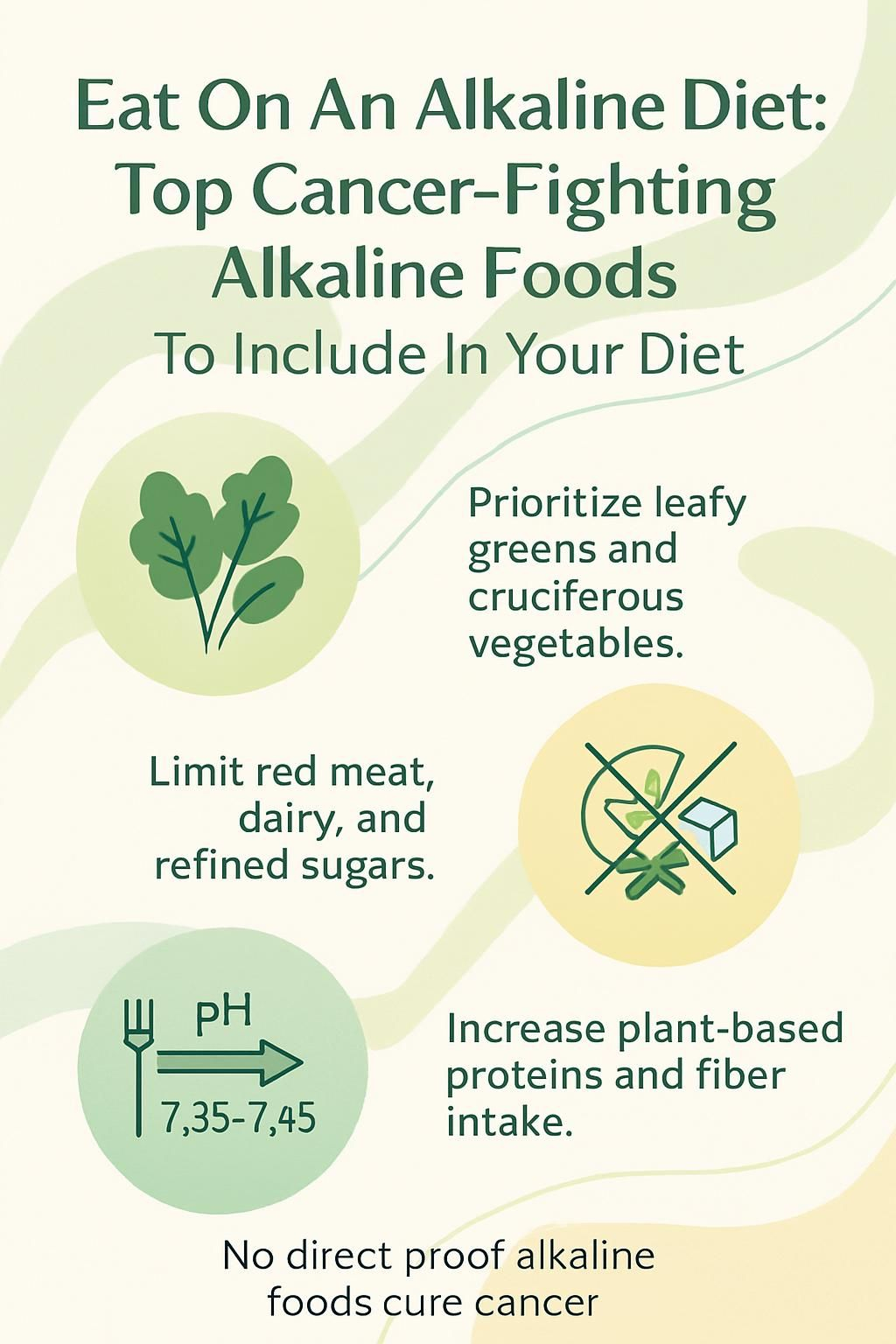Eat On An Alkaline Diet: Top Cancer-Fighting Alkaline Foods To Include In Your Diet
Our Nutrition Assistant AI Suite will transform your body. You will lose fat, get toned, and build muscle. Gain confidence and optimal health.
Many people want to lower cancer risk yet feel unsure about which foods help most. I hear this often, and I have felt it too. An alkaline diet focuses on plant-rich choices that lower dietary acid load. That shift supports kidney work, improves nutrient intake, and may reduce inflammation linked to chronic disease.
This guide gives clear, evidence-based advice on fruits, leafy greens, legumes, and other whole foods. You will see which choices fit daily life and how they relate to health markers like blood pressure and digestion.
If you want simple steps and honest answers about top cancer-smart alkaline foods, you are in the right place. Keep reading for practical tips you can use today. This article is educational and not medical advice. Talk with your clinician about your personal needs.
Key Takeaways
- An alkaline-style menu centers on leafy greens, cruciferous vegetables, legumes, nuts, seeds, and fruits. These foods are linked with lower inflammation and better weight control.
- Research, including a 2012 review in the Journal of Environmental and Public Health, suggests plant-forward, high-alkaline foods may support bone health and improve calcium balance.
- Your blood pH stays tightly controlled near 7.35 to 7.45. Food choices change urine pH and acid load, and they influence wellness through fiber, minerals, and antioxidants.
- Limiting red meat, processed foods, refined sugars, soda, fried items, and heavy alcohol can improve digestion and heart risk markers. Choosing plant-based proteins helps too.
- There is no proof that alkaline foods cure cancer. Eating more whole plant foods raises fiber and nutrients and may lower exposure to harmful additives.

What is an Alkaline Diet?

An alkaline diet emphasizes foods that produce a lower potential renal acid load or PRAL. PRAL is a simple estimate of how foods affect the body’s acid load, which the kidneys handle. Foods like leafy greens, vegetables, fruits, legumes, and some whole grains tend to have a lower PRAL.
What are the basic principles of an alkaline diet?
The alkaline diet is based on eating foods that reduce dietary acid load. I focus on plant-based options, such as leafy greens, cruciferous vegetables, beans, lentils, seeds, and whole grains.
I limit acid-forming foods like red meat, processed meats, full-fat dairy, refined sugars, soda, and ultra-processed snacks. These foods often add sodium, additives, and phosphorus, which can raise acid load.
This approach keeps the spotlight on whole, unprocessed foods rich in potassium and magnesium. Those minerals are common in fresh produce, and they help the kidneys manage acid-base balance. I also use beans or lentils for protein, which reduces my reliance on animal proteins.
How does pH balance affect the body?
Blood pH is tightly controlled, usually between 7.35 and 7.45 on the pH scale. This control is called acid-base homeostasis. Small shifts can affect how organs work, so the body uses the lungs and kidneys to keep pH stable.
The kidneys remove extra acids through urine and regulate minerals like calcium and potassium. A plant-forward diet supports this work with fiber and minerals that reduce dietary acid load.
Daily food choices shape our inner chemistry in small but meaningful ways,
a registered dietitian wrote. Diets high in processed meats and added sugar are linked with higher inflammation and poorer bone health.
Choosing vegetables, fruits, beans, nuts, and seeds helps digestion and may support bone mineral density. These habits build long-term health one plate at a time.
Your plate has power, and steady habits add up.
Benefits of an Alkaline Diet
Many people choose to eat on an alkaline diet because plant-rich meals support healthy body functions. I also like that this style fits real life and does not require fancy products.
How can an alkaline diet improve overall health?
Eating more alkaline foods, like kale, berries, beans, and nuts, can reduce inflammation and support heart health. People who eat more plants often have better blood pressure and weight control than those who rely on ultra-processed foods.
When I leaned into greens, legumes, and whole grains, my energy felt more stable. My digestion also improved. I credit the extra fiber and fewer sugary snacks.
Plant foods bring antioxidants that protect cells from damage. That protection supports healthy aging and daily performance.
Can an alkaline diet help fight cancer?
Many readers ask about diet and cancer. Current research does not show that food can change blood pH to stop tumors. Still, plant-rich diets are linked with lower cancer risk in population studies, mainly due to fiber, vitamins, and phytochemicals like carotenoids and polyphenols.
Leafy greens, broccoli, and nuts supply nutrients that may protect cells from damage. While the evidence is not a cure claim, these foods are smart foundation choices for overall health.
Legumes like kidney beans add fiber that helps the gut remove waste products. A healthy gut can reduce contact with carcinogens that form during fat digestion.
How does an alkaline diet enhance digestion and nutrient absorption?
Leafy greens and cruciferous vegetables are rich in fiber and magnesium. Fiber supports regularity, while magnesium helps muscles and nerves work well, including those in the gut.
Many alkaline foods provide prebiotics, which feed friendly gut bacteria. Strong gut bacteria help break down food so the body can absorb vitamins and minerals more easily.
When I shifted from heavy processed meals to plant-focused plates, bloating eased. I felt comfortable after eating, and my meals kept me fuller longer.
Does an alkaline diet reduce the risk of chronic diseases?
Clinical research links plant-based eating with a lower risk of heart disease, type 2 diabetes, and chronic kidney disease. The benefit comes from more fiber, better fats, lower sodium, and fewer additives.
Some studies find better lipid profiles and lower inflammation markers in people who choose these foods regularly. While pH itself is not the main driver, plant-focused patterns show real promise for long-term health.
Cutting back on acid-forming foods also reduces exposure to additives and excess sugar. That move helps almost every system in the body.
Foods to Avoid on an Alkaline Diet
The alkaline diet restricts many ultra-processed items. I plan ahead so I have fresh options ready, which makes this easier and more affordable.
Which acidic foods should be avoided?
Certain foods raise dietary acid load and crowd out healthier options. I limit these choices:
- Red and processed meats like beef, bacon, sausage, and deli slices
- Soda and energy drinks, which supply phosphoric acid and added sugars
- Refined grains, including white bread, pastries, and many boxed cereals
- Most full-fat dairy like cheese and ice cream
- Alcohol, since it breaks down into acids and adds empty calories
- Chocolate candies high in added sugar and stimulants
- Packaged snacks with preservatives and artificial flavors
- High-sodium foods that strain kidneys and raise blood pressure
- Fried foods that add inflammatory compounds during high-heat cooking
Why avoid refined sugars and artificial additives?
Diets high in added sugars push out nutrient-dense foods. Sugary drinks supply calories without vitamins, minerals, or fiber. That pattern raises risk for weight gain and type 2 diabetes.
Artificial colors and preservatives may bring extra chemical load with no benefit. Choosing whole foods reduces guesswork and supports steady energy.
When I swapped packaged snacks for fruit, nuts, and homemade yogurt bowls, I felt less sluggish. My workouts were easier, and cravings dropped.
Top Cancer-Fighting Alkaline Foods
Cancer-fighting foods are mostly everyday plants. Think simple staples that fill half your plate.
Leafy Green Vegetables: Kale, Spinach, and Swiss Chard
Kale, spinach, and Swiss chard are nutrient-dense and low in calories. They deliver vitamins A, C, E, and K along with minerals like magnesium and potassium.
Spinach offers magnesium that supports muscle function and digestive rhythm. Swiss chard supplies potassium and iron and may help calm inflammation.
I build many salads with kale or spinach and add beans for protein. Steamed chard is easy to tuck into pasta or grain bowls.
Cruciferous Vegetables: Broccoli, Cabbage, and Brussels Sprouts
Broccoli, cabbage, and Brussels sprouts contain sulforaphane, a plant compound studied for cell protection. They also provide fiber and vitamin C, two allies for immune health.
These vegetables are versatile. I roast Brussels sprouts with olive oil and lemon, shred cabbage into slaws, and steam broccoli for quick sides.
Eating a mix each week helps me meet mineral needs without relying on supplements.
Alkaline Fruits: Avocados, Lemons, and Apples
Avocados supply healthy fats and potassium, which supports fluid balance. Lemons taste acidic, yet their minerals leave an alkaline effect after digestion.
Apples bring fiber and vitamin C, plus plant compounds that may reduce inflammation. I mash avocado on whole grain toast, add lemon to water, and keep apples as a grab-and-go snack.
Legumes and Beans: Lentils, Chickpeas, and Kidney Beans
Lentils, chickpeas, and kidney beans provide plant protein and steady energy. A cup of cooked lentils supplies about 18 grams of protein with plenty of fiber.
These legumes also deliver iron, magnesium, and potassium. Fiber supports a healthy gut and has been linked with a lower risk of colon cancer in large reviews.
I use chickpeas in wraps, lentils in soups, and kidney beans in chili. Simple, filling, and budget friendly.
Nuts and Seeds: Almonds, Sunflower Seeds, and Flaxseeds
Almonds bring vitamin E and fiber. Sunflower seeds are rich in magnesium and selenium, minerals involved in immune support.
Flaxseeds offer omega-3 fats and lignans, which have been studied for potential cancer risk reduction. I grind flax and add it to smoothies or oatmeal to improve absorption.
A small handful of nuts or seeds makes a strong snack with lasting power.
Alkaline Beverages: Green Tea and Herbal Infusions
Green tea is a natural source of antioxidants. Research links green tea with lower oxidative stress, which can support cell health.
Herbal infusions like mint, chamomile, nettle, or dandelion are caffeine free and hydrating. They fit well if I am replacing soda or sweetened drinks.
If you are sensitive to caffeine, choose decaf green tea or herbal blends.
Plant-Based Proteins on an Alkaline Diet
Plant proteins help me meet goals without adding excess saturated fat. They also boost fiber, which most people need more of.
Tofu and Tempeh
Tofu and tempeh both come from soybeans. Tofu is smooth and mild, while tempeh is firm with a nutty taste.
Tofu delivers roughly 8 grams of protein per 100 grams. Tempeh often doubles that and includes fiber from the whole bean.
I add tofu to stir-fries and soups because it absorbs flavor. Tempeh works in tacos or sandwiches. Both supply helpful minerals like calcium, iron, and magnesium that support bones and muscles.
Edamame and Soybeans
Edamame and soybeans are easy, high-quality plant proteins. A cup of cooked edamame has about 18 grams of protein.
Soy also contains isoflavones, plant compounds studied for heart and cell health. I steam edamame for snacks and toss roasted soybeans into salads for crunch.
If you have a thyroid condition or soy allergy, talk with your clinician before making big changes.
Tips for Following an Alkaline Diet
I keep things simple. I cook once, eat twice, and stay flexible with seasonal produce.
How to include more plant-based meals?
Here are steps that help me add plants without stress:
- Plan weekly lunches with leafy greens, carrots, or beets as the base.
- Swap one daily meat serving for dal, lentils, tofu, or edamame.
- Add a handful of almonds or seeds to breakfast or snacks.
- Build colorful salads with apples, avocado, and broccoli; top with sunflower seeds or ground flax.
- Use beans or chickpeas in tacos and wraps instead of processed meat.
- Pick green tea or herbal infusions instead of soda to cut added sugar.
- Cook extra at dinner so lunch is ready for tomorrow.
- Choose whole grains like quinoa or brown rice with stir-fried kale or spinach.
- Try one new produce item each month to keep meals fresh and fun.
Why is staying hydrated with alkaline water important?
Hydration supports digestion, focus, and energy. Some mineral waters are alkaline and provide calcium, magnesium, and potassium.
Evidence on alkaline water is mixed, yet many people enjoy the taste. I choose clean water sources and drink regularly through the day.
If you have kidney disease or take medications, ask your clinician which water type fits your plan.
How to prepare meals using fresh, whole ingredients?
Cooking with fresh, whole foods preserves nutrients and flavor. These simple habits help me stay consistent:
- Wash produce well to remove dirt and pesticide residue.
- Pick local or organic items when possible to reduce additives.
- Chop vegetables close to cooking time to protect nutrients.
- Use steaming, roasting, or sautéing instead of deep frying.
- Skip refined sugars; sweeten with fruit or a squeeze of lemon.
- Pair legumes with leafy greens for a nutrient-dense bowl.
- Sprinkle almonds, pumpkin seeds, or ground flax on salads or oats.
- Brew green tea or herbal infusions at home to avoid added sweeteners.
- Marinate tofu with herbs, citrus, and garlic instead of salty sauces.
- Drink water during prep and meals to aid digestion.
Common Myths About the Alkaline Diet
There is a lot of confusion online. Getting the science right keeps your plan safe and effective.
What are the misconceptions about pH and cancer?
Some claim alkaline foods change blood pH to stop cancer. That is not how the body works. Blood pH remains tightly controlled, and food does not shift it in a meaningful way.
Diet can change urine pH, which reflects how the kidneys remove acids. That is normal. It does not mean you changed the pH of blood or a tumor.
Choosing an alkaline-style diet may lower cancer risk through fiber, antioxidants, weight control, and less processed meat. Those are sensible benefits without the false promise.
How does diet affect body pH levels?
What I eat can raise or lower urine pH. These changes show how the body handles dietary acids and bases.
Mineral-rich plants help neutralize acids created during digestion of certain proteins and grains. That support reduces dietary acid load, which may help kidney efficiency.
Medical experts agree that diet does not meaningfully change blood pH in healthy people. The lungs and kidneys manage that balance tightly around 7.4.
Scientific Research on the Alkaline Diet
Many studies explore alkaline-style eating. Most focus on plant-rich patterns, inflammation, bone balance, and kidney stress.
What evidence supports the health benefits of an alkaline diet?
Research links higher intakes of fruits, vegetables, nuts, and legumes with lower risk of hypertension and kidney stones. Diets with lower PRAL may improve calcium balance and support muscle mass in older adults.
A 2012 review in the Journal of Environmental and Public Health reported possible bone benefits tied to alkaline-forming foods. Plant-forward diets also displace refined sugars and additives, which supports weight control and metabolic health.
I noticed smoother digestion after increasing leafy greens and legumes. This matches research on fiber-rich diets and gut function.
What areas still need more research?
Scientists still study links between alkaline diets and cancer outcomes. Many findings come from lab work or small trials, so large human studies are needed.
We also need better data on which specific food groups make the biggest difference and how long-term restrictions affect nutrition. Controlled trials over several years would help answer these questions.
For now, the strongest evidence supports eating more plants, fewer ultra-processed foods, and enough protein and minerals for daily needs.
How to Get Started on an Alkaline Diet
I began with small swaps and a short shopping list. A little planning made it easy to stick with.
What are simple meal planning tips for beginners?
Here is a structure that works for me:
- Make a weekly menu with leafy greens, legumes, and fruits like avocado and apples.
- Write a list guided by credible sources and keep it focused on whole foods.
- Batch cook lentils or quinoa to save time on weekdays.
- Replace sugary snacks with almonds, sunflower seeds, or fruit.
- Keep washed produce at eye level in the fridge for quick salads and stir-fries.
- Choose green tea or herbal infusions instead of sweet drinks.
- Season with lemon juice, garlic, and herbs to boost flavor without additives.
- Rotate meals to cover a range of vegetables like broccoli, kale, and cabbage.
- Prep on Sunday night so healthy choices are ready during busy days.
These steps make it simple to add more cancer-smart alkaline foods to daily meals.
How to gradually transition to alkalizing foods?
Small, steady changes work best. Here is a plan I use with clients and myself:
- Add a serving of leafy greens to one meal daily.
- Swap soda for water with lemon or unsweetened iced tea.
- Trade refined grains for whole grain or sprouted bread.
- Pick one cruciferous vegetable twice a week at dinner.
- Carry almonds or sunflower seeds for a protein-rich snack.
- Replace two meat servings a week with tofu, tempeh, lentils, or chickpeas.
- Use fresh ingredients and skip pre-packaged sauces high in sodium.
- Track meals for two weeks; note energy, digestion, and mood.
- Discuss big changes with your clinician, especially if you have kidney disease or take medications.
Conclusion
I build my plate around top alkaline foods such as leafy greens, broccoli, avocados, beans, and almonds. This plant-forward pattern supports a healthier acid load, steady digestion, and strong day-to-day energy.
While food will not change your blood pH, an alkaline diet helps you choose nutrient-dense meals and limit ultra-processed, acidic foods. Evidence points to benefits for bone balance, heart health, weight control, and gut function. Start with simple swaps, and let those small wins guide the next step.
Sources: Journal of Environmental and Public Health, 2012 review on alkaline diet and health; major reviews on fruit, vegetables, fiber, and chronic disease risk published in peer-reviewed journals.
FAQs
1. What is an alkaline diet and how does it relate to cancer prevention?
An alkaline diet focuses on foods that help maintain a balanced pH in the body, such as leafy greens, fruits, and certain nuts. Peer-reviewed studies suggest that eating more plant-based foods may support overall health. This approach also restricts many foods high in acid, like processed meats or refined sugars.
2. Which top cancer-fighting alkaline foods should I include in my meals?
Include spinach, kale, broccoli, cucumbers, avocados, and almonds for their alkalizing effects and nutrient content. These choices are supported by high-quality sources that highlight their potential benefits for reducing disease risk.
3. Are there any risks with following an alkaline diet?
The plan also restricts many foods including some animal proteins and grains which can lead to nutritional gaps if not managed carefully. Using only high-quality sources helps ensure you make informed decisions about your food intake.
4. How reliable is the information about the benefits of an alkaline diet?
This guide uses only high-quality sources including peer-reviewed studies to present accurate data on nutrition and health outcomes related to this way of eating. Reliable evidence supports each recommendation provided here.
Summary: An alkaline diet encourages plant-based options while restricting certain acidic items; credible research backs its possible role in supporting wellness when based on well-sourced information.







